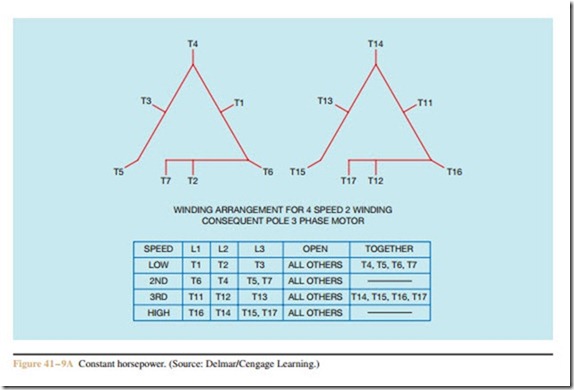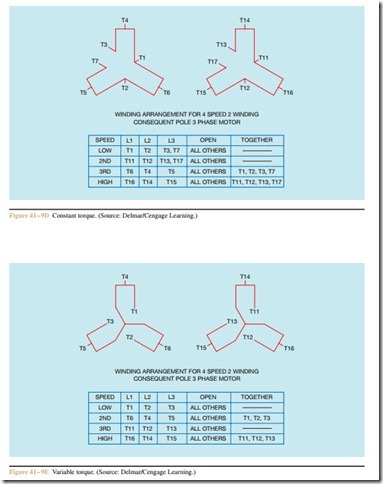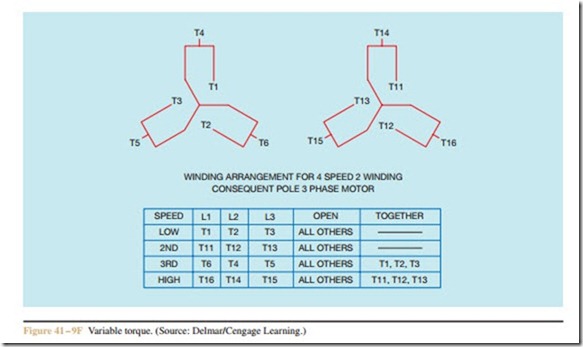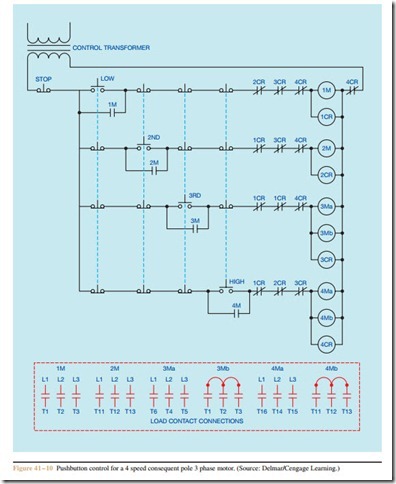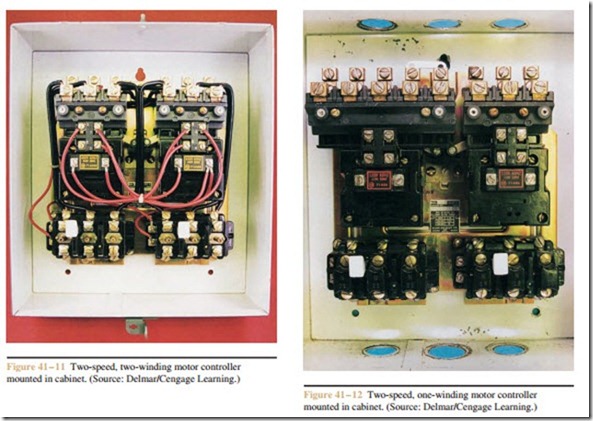Four-Speed Consequent Pole Motors
Consequent pole motors intended to operate with four speeds use two reconnectable windings. Like two-speed or three-speed motors, four-speed motors can be wound to operate at constant horsepower, constant torque, or variable torque. Some examples of winding connections for four-speed, two-winding three-phase con- sequent pole motors are shown in Figures 41 – 9A through 41 – 9F.
A circuit for controlling a four-speed, three-phase consequent pole motor is shown in Figure 41 – 10. The control permits any speed to be selected by pushing the button that initiates that particular speed. In this circuit, stacked push buttons are used to break the circuit to any other speed before the starter that controls the selected speed is energized. Electrical interlocks are also used to ensure that two speeds cannot be energized at the same time. Eleven-pin control relays are used to pro- vide interlock protection because they each contain three sets of contacts.
The load contact connection is also shown in Figure 41 – 10. The circuit assumes the connection diagram for the motor is the same as the diagram illustrated in Figure 41 – 9F. The circuit also assumes that the starters and contactors each contain three load contacts. Note that 3RD speed and HIGH speed require the use of two contactors to supply the necessary number of load contacts.
A two-speed, two-winding motor controller and a two-speed, one-winding motor controller are shown in Figure 41 – 11 and Figure 41 – 12.
Review Questions
1. Name two factors that determine the synchronous speed of a motor.
2. How many speeds can be obtained from a consequent pole motor that contains only one stator winding?
3. What is the advantage of consequent pole motors over some other types of variable speed motors?
4. A consequent pole motor has synchronous speeds of 1800, 1200, and 900 RPM. How many stator windings does this motor have?
5. Refer to the circuit shown in Figure 41–6. You are to install this control system. How many auxiliary contacts should starter 1L contain? List how many are normally open and how many are normally closed.
6. Refer to the circuit shown in Figure 41–6.
What is the function of contactor 2L?
7. Refer to the circuit shown in Figure 41–7. When the low speed push button is pressed, the motor begins to run in low speed. When the high push button is pressed the motor stops running. Which of the following could cause this problem?
a. 1L contactor coil is open.
b. H contactor coil is open.
c. PR relay coil is open.
d. 2L contactor coil is open.
8. Refer to the circuit shown in Figure 41–10.
Assume that coil 2CR is shorted. Would it be possible to run the motor in third speed?
9. Refer to the circuit shown in Figure 41–10. Ex- plain the action of the circuit if coil 2CR is shorted and the 2ND speed push button is pressed.
10. Refer to the circuit shown in Figure 41–10. You are to construct this circuit on the job. Would it be possible to use an eleven-pin control relay for 4CR?
